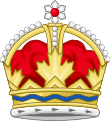This article may be too technical for most readers to understand. (January 2016) |
 |
|---|
| Part of a series on the |
| Constitution of Canada |
|---|
 |
|
|
Canadian federalism (French: fédéralisme canadien) involves the current nature and historical development of the federal system in Canada.
Canada is a federation with eleven components: the national Government of Canada and ten provincial governments. All eleven governments derive their authority from the Constitution of Canada. There are also three territorial governments in the far north, which exercise powers delegated by the federal parliament, and municipal governments which exercise powers delegated by the province or territory. Each jurisdiction is generally independent from the others in its realm of legislative authority.[1] The division of powers between the federal government and the provincial governments is based on the principle of exhaustive distribution: all legal issues are assigned to either the federal Parliament or the provincial Legislatures.
The division of powers is set out in the Constitution Act, 1867 (originally called the British North America Act, 1867), a key document in the Constitution of Canada. Some amendments to the division of powers have been made in the past century and a half, but the 1867 act still sets out the basic framework of the federal and provincial legislative jurisdictions. The division of power is reliant upon the "division" of the unitary Canadian Crown and, with it, of Canadian sovereignty, among the country's 11 jurisdictions.
The federal nature of the Canadian constitution was a response to the colonial-era diversity of the Maritimes and the Province of Canada, particularly the sharp distinction between the French-speaking inhabitants of Lower Canada and the English-speaking inhabitants of Upper Canada and the Maritimes. John A. Macdonald,[2] Canada's first prime minister, originally favoured a unitary system.[3]
- ^ Banting, Keith G.; Simeon, Richard (1983). And no one cheered: federalism, democracy, and the Constitution Act. Toronto: Methuen. pp. 14, 16. ISBN 0-458-95950-2.
- ^ "Biography – MACDONALD, Sir JOHN ALEXANDER – Volume XII (1891-1900) – Dictionary of Canadian Biography". www.biographi.ca. Retrieved 1 February 2019.
- ^ "John A. Macdonald on the Federal System". The Historica-Dominion Institute. Archived from the original on 27 June 2013. Retrieved 24 December 2012., quoting Parliamentary Debates on the Subject of the Confederation of the British North American Provinces—3rd Session, 8th Provincial Parliament of Canada. Quebec: Hunter, Rose & Co. 1865. pp. 29–45.
